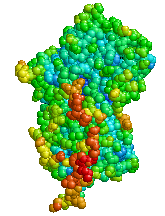Antitrypsin
α1-antitrypsin (A1AT, AAT) is a protein formed in the liver, from where it is released into the bloodstream. Its deficiency can lead to pulmonary emphysema, and its dysfunctional formation leads to cholestatic liver disease (cirrhosis of the liver, hepatoma), due to the accumulation of abnormal AAT in hepatocytes. AAT deficiency is currently the most common cause of liver transplantation in children.[1]
AAT is among the acute phase reactants. AAT is a protease inhibitor that inactivates a number of enzymes. One of them is elastase of neutrophils in the lung tissue, which is a physiological part of the body's protection during injury and inflammation, but at the same time it is dangerous for the lung tissue due to its proteolytic activity. An increased concentration of AAT in the serum is common not only with infections, but also with the use of oral contraceptives, pregnancy, stress and inflammation of the thyroid gland. The concentration of AAT can be reduced in neonatal respiratory distress syndrome and in conditions where the concentration of serum proteins is reduced, such as kidney disease (nephrotic syndrome), malnutrition and in some tumors.[1]
AAT is formed as a product of two copies of the Pi gene – the protease inhibitor gene. This gene is codominant, meaning that each copy is responsible for half of the body's AAT production. If one or both genes are mutated, little ATT or dysfunctional AAT is produced. In patients with less than 30% of the physiological production of AAT, we speak of alpha-1 antitrypsin deficiency. Around 10% of patients with AAT deficiency have jaundice after birth. In many patients, the condition improves, but severe disability requires a liver transplant in childhood.[1]
Indications for examination of the level of AAT in the serum[edit | edit source]
- Newborns and young children with jaundice that persists for more than 1-2 weeks after birth.
- Splenomegaly, ascites, itching and other signs of liver disease in children.
- Those under 40 who develop shortness of breath, have a chronic cough or bronchitis, have labored breathing, and have other signs of emphysema, especially in nonsmokers and those not exposed to lung irritants..
- Relatives of individuals with AAT deficiency.[1]
Indications for AAT DNA examination[edit | edit source]
- demonstrated reduced AAT concentration;
- suspected differential formation of the AAT variant;
- lack of AAT formation;
- relatives of persons with AAT deficiency (including determining the risk of transmission to children).[1]

